Nestled between the rugged Pacific coastline and the majestic Cascade Mountains, Oregon boasts an incredibly diverse ecosystem, providing a home to a myriad of vibrant bird species.
Among them, the state’s red-hued avians stand out for their striking beauty and captivating presence. In our specially curated guide, we introduce you to 12 of Oregon’s most dazzling red birds.
Accompanied by a complimentary photo guide, you’ll be transported into the heart of Oregon’s avian splendor, appreciating each feathered wonder up close. Dive in and let these red wonders of the skies enthrall you!
Red Birds Found In Oregon
The state’s rich topographical variations, from coastal habitats to alpine meadows and high desert regions, ensure a vast array of ecosystems. These diverse habitats, coupled with the Pacific Flyway migration route, which passes directly through Oregon, contribute to its avian richness.
Northern Cardinal


| Feature | Measurement |
|---|---|
| Scientific Name | Cardinalis cardinalis |
| Length | 8.3 – 9.1 in |
| Wingspan | 9.8 – 12.2 in |
| Weight | 1.19 – 2.29 oz |
The Northern Cardinal is an iconic North American bird, easily recognized by its vibrant color and melodious song.
Appearance: Male Northern Cardinals are a brilliant scarlet red, while females display a more subdued reddish olive. Both sexes have a distinctive black ‘mask’ on their face around the bill and a pointed crest on their head. The bird’s beak is robust, cone-shaped, and bright orange in color.
Diet: Northern Cardinals are primarily granivorous, with a diet largely consisting of seeds and grains. They also eat fruits and insects. These birds typically feed off the ground and are frequent visitors to bird feeders.
Reproduction: Northern Cardinals are monogamous, and a pair will breed together for life. The female typically builds a well-hidden nest in a dense thicket or shrub. She lays 2-5 eggs per clutch, which she incubates for around two weeks.
House Finch


| Feature | Measurement |
|---|---|
| Scientific Name | Haemorhous mexicanus |
| Length | 5–6 in |
| Wingspan | 8–10 in |
| Weight | 0.6–0.9 oz |
The House Finch is a small songbird widely distributed across North America and is commonly found in urban and suburban areas.
Appearance: Males of this species are brightly colored with crimson faces and throats, which can extend to the chest and back, while their flanks have streaks. The female is streaked brown and lacks the red coloring. Both have a square-tipped tail and a distinctively long, flat-topped bill.
Diet: House Finches primarily eat seeds, grains, and berries. They have a particular fondness for sunflower seeds and can be commonly seen at bird feeders. Occasionally, they will also consume insects, especially during the breeding season.
Reproduction: House Finches are cavity-nesters and might choose ledges, vents, ledges, and other urban settings. They might also utilize trees or shrubs. Their nests can be made of a wide array of materials, from feathers to twigs.
Red Crossbill

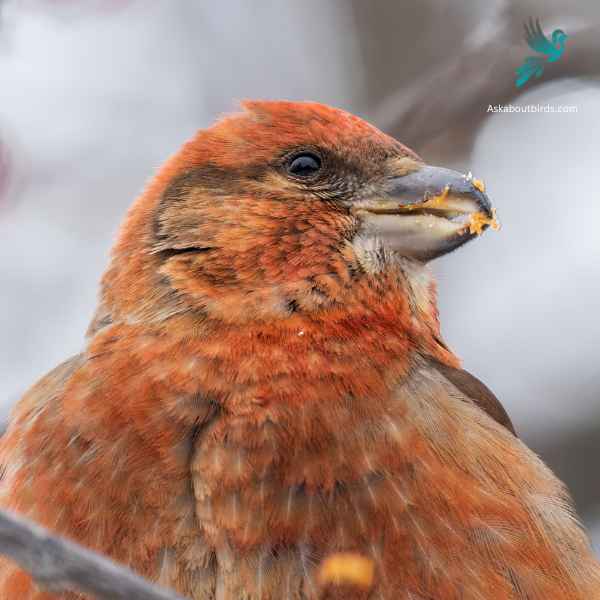
| Feature | Measurement |
|---|---|
| Scientific Name | Loxia curvirostra |
| Length | 5.5–7.5 in |
| Wingspan | 9.8–10.6 in |
| Weight | 0.9–1.4 oz |
The Red Crossbill is a distinctive finch known for its unusual bill, which has evolved to extract seeds from conifer cones.
Appearance: Males are typically bright red or orange, while females are greenish-yellow or olive. Both genders have the characteristic crossed bill, which they use to expertly extract seeds from tightly closed conifer cones.
Diet: Red Crossbills primarily feed on the seeds of coniferous trees, such as spruce, pine, and fir. Their specialized bills allow them to efficiently pry apart conifer cone scales to access the seeds.
Reproduction: Red Crossbills are somewhat nomadic and don’t adhere to a strict breeding schedule. Instead, they breed whenever and wherever food is abundant. Their nests are usually built on horizontal branches of conifer trees.
Pine Grosbeak

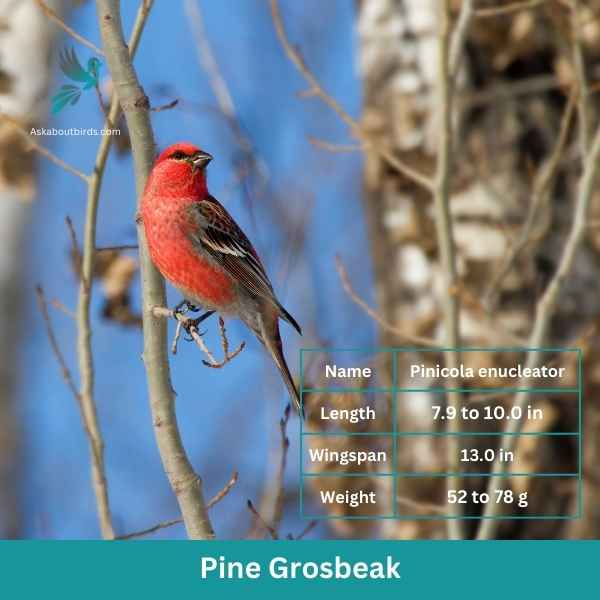
| Feature | Measurement |
|---|---|
| Scientific Name | Pinicola enucleator |
| Length | 7.9 to 10.0 in |
| Wingspan | 13.0 in |
| Weight | 52 to 78 g |
The Pine Grosbeak is a striking bird native to the northern regions of North America, often found in coniferous forests. Both males and females have a plump and robust body with a large beak adapted for eating seeds. The male Pine Grosbeak displays a vibrant reddish-pink plumage, while the female has a more subdued grayish-brown coloration.
These birds are typically seen in small flocks, foraging for food in trees and on the ground. They have a preference for seeds, particularly those from various conifer species. The Pine Grosbeak uses its strong bill to crack open the cones of tall trees and extract the seeds, but they also consume berries and small fruits when available.
Cassin’s Finch

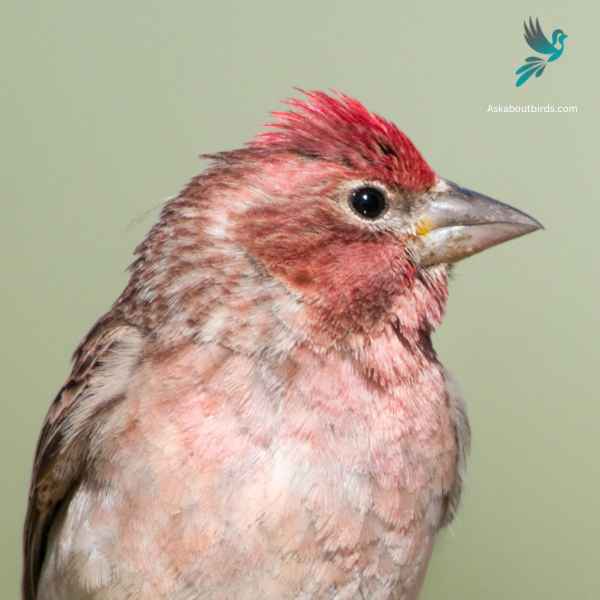
| Feature | Measurement |
|---|---|
| Scientific Name | Haemorhous cassinii |
| Length | 6.0-6.5 in |
| Wingspan | 9.5-10.5 in |
| Weight | 0.8-1.0 oz |
The Cassin’s Finch is a small songbird known for its melodic song and affinity for high-elevation forests.
Appearance: Male Cassin’s Finches are pinkish-red on the crown and throat, contrasting with their streaked brown back and wings. Females lack the bright coloring, appearing streaked brown throughout with a pale eyebrow stripe. Both sexes have a notched tail and a slightly curved bill.
Diet: Cassin’s Finches mainly feed on seeds, particularly from conifers. They also eat insects, especially during the breeding season. Their feeding habits often bring them to bird feeders where they readily eat sunflower seeds.
Reproduction: Cassin’s Finches nest in trees, preferring coniferous forests. The nest is made from twigs, grasses, and feathers. Typically, the female lays 3 to 5 eggs and handles most of the incubation. Both parents partake in feeding the fledglings once they hatch.
Summer Tanager


| Feature | Measurement |
|---|---|
| Scientific Name | Piranga rubra |
| Length | 6.7 in |
| Wingspan | 28 to 30 cm |
| Weight | 29 g |
The Summer Tanager is a medium-sized songbird admired for its radiant plumage and melodious song.
Appearance: Male Summer Tanagers are an impressive bright red, while females and juveniles present a softer, yellow-orange color. Both genders have a large, slightly hooked bill and relatively short tail.
Diet: Summer Tanagers primarily feed on insects, including bees and wasps, which they catch in flight or pick off vegetation. They are also known to eat fruits and berries, making them helpful in controlling pest populations and seed dispersal.
Reproduction: The female Summer Tanager builds a loose, shallow cup-shaped nest out of twigs and grass, usually hidden in the foliage of trees. The female typically lays 3-5 eggs, which she will incubate for about two weeks.
Scarlet Tanager


| Feature | Measurement |
|---|---|
| Scientific Name | Piranga olivacea |
| Length | 6.3 to 7.5 in |
| Wingspan | 9.8 to 11.8 in |
| Weight | 23.5 to 38 g |
The Scarlet Tanager is a strikingly colorful bird known for its brilliant plumage and distinctive song.
Appearance: Male Scarlet Tanagers are notable for their vibrant scarlet bodies contrasted with black wings and tail, making them one of the most intensely colored birds. Females and juveniles, on the other hand, have a subdued olive-yellow body color with darker wings and tail.
Diet: The diet of the Scarlet Tanager is largely made up of insects, including beetles, cicadas, aphids, and others. They are adept flycatchers, seizing insects in mid-air or picking them off foliage. They also consume fruits and berries, especially during migration and in their winter habitats.
Reproduction: The female Scarlet Tanager builds a cup-shaped nest using twigs, rootlets, and grass, typically well-hidden in the dense foliage of trees. She lays 3 to 5 eggs and incubates them for about two weeks.
Western Tanager

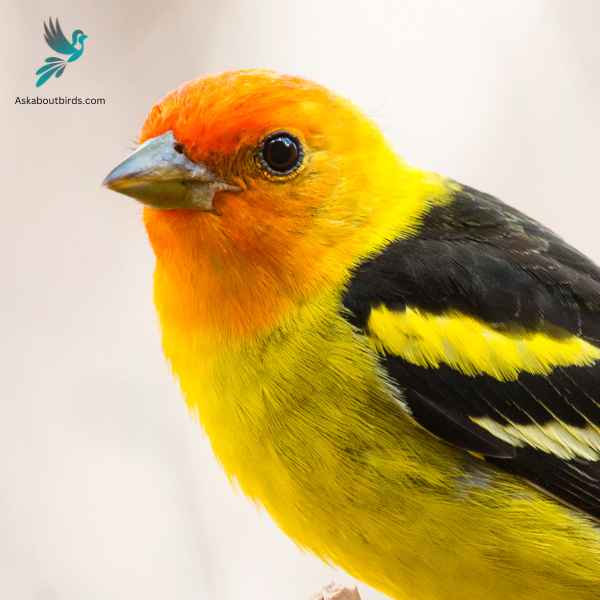
| Feature | Measurement |
|---|---|
| Scientific Name | Piranga ludoviciana |
| Length | 6.3-7.5 in |
| Wingspan | 11.5 in |
| Weight | 24-36 g |
The Western Tanager is a vibrant songbird that graces the forests and woodlands of the western regions of North America, enchanting observers with its colorful plumage and melodious song.
Appearance: The male Western Tanager is renowned for its bright yellow body contrasted with a striking red head and black wings and tail. The females are more subdued in hue, primarily being yellow with grayish wings and back, and lacking the brilliant red head of the males.
Diet: Western Tanagers primarily feed on insects, especially when breeding, but they also incorporate a significant amount of fruits and berries into their diet, especially during migration and winter.
Reproduction: Western Tanagers build their nests high in coniferous trees, often well concealed from potential predators. The female usually lays a clutch of 3 to 5 eggs and takes the primary role in incubation, while both parents are involved in feeding the chicks after they hatch.
Rufous Hummingbird


| Feature | Measurement |
|---|---|
| Scientific Name | Selasphorus rufus |
| Length | 3.1–3.9 in |
| Wingspan | 4.3 in |
| Weight | 0.1–0.2 oz |
The Rufous Hummingbird is a small, brilliantly colored bird known for its impressive migratory journeys and feisty behavior.
Appearance: The male Rufous Hummingbird boasts a gleaming orange-red body with a white chest and an iridescent red throat, called a gorget. The female has green upperparts with rufous-washed flanks and tail. Her throat may have some iridescent patches, but it’s generally whitish.
Diet: Like other hummingbirds, the Rufous Hummingbird primarily feeds on nectar from a variety of flowering plants. They also eat insects and spiders for protein, catching them in flight or plucking them from vegetation.
Reproduction: Rufous Hummingbirds nest in trees, shrubs, or even ferns. The female alone selects the site, builds the nest, and cares for the offspring.
American Robins


| Feature | Measurement |
|---|---|
| Scientific Name | Leptotila plumbeicep |
| Length | 10.6-11.8 in |
| Wingspan | — |
| Weight | 160-200 g |
The American Robin is a widely recognized bird species known for its melodious song and early bird tendencies.
Appearance: American Robins are medium-sized birds with a distinctive appearance. Both males and females sport a gray to brown back and a warm red to orange breast and belly and gray wings. They also have a characteristic white eye-ring and a black head, but males are usually darker than females.
Diet: American Robins have a diverse diet that changes depending on the season. In summer, they feed heavily on earthworms, beetles, and other invertebrates, which they catch on the ground. During winter, they mostly eat fruits and berries.
Reproduction: American Robins usually build their nests in trees or shrubs, but they are also known to nest on human-made structures. The female lays a clutch of about 3 to 5 eggs, which she incubates for about 12 to 14 days.
Red-breasted Sapsucker
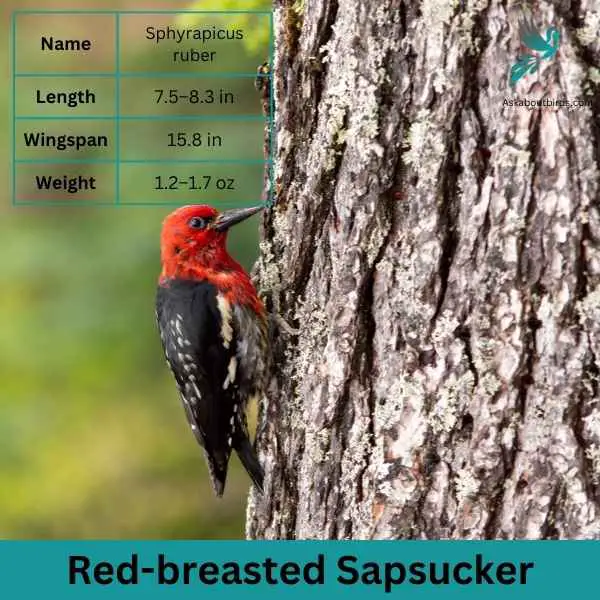
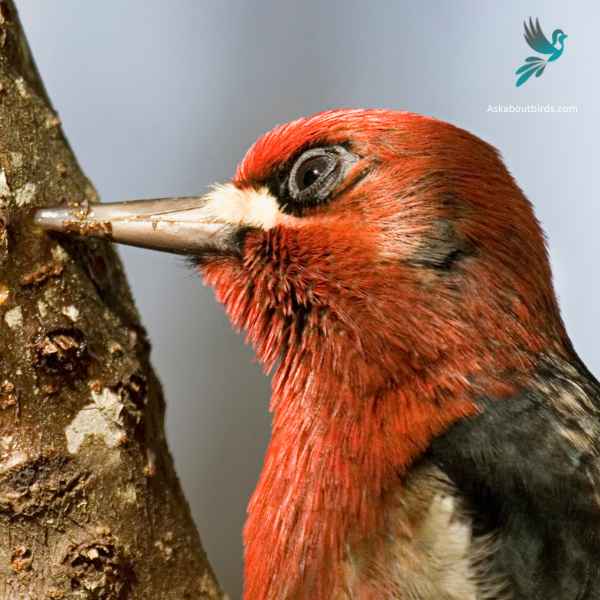
| Feature | Measurement |
|---|---|
| Scientific Name | Sphyrapicus ruber |
| Length | 7.5–8.3 in |
| Wingspan | 15.8 in |
| Weight | 1.2–1.7 oz |
The Red-breasted Sapsucker is a medium-sized woodpecker known for its vibrant coloration and distinctive foraging habits.
Appearance: This bird is primarily recognizable by its bright red head, breast, and flanks. The wings are black with white barring, and there’s a prominent white stripe running vertically down the wing. Its back is barred with black and white.
Diet: True to their name, Red-breasted Sapsuckers drill series of small holes in trees to feed on sap. They also consume insects attracted to this sap, as well as berries and fruits when available.
Reproduction: Red-breasted Sapsuckers create nest cavities in dead or decaying trees, and sometimes in living trees where the heartwood is decayed.
Red-Winged Blackbird
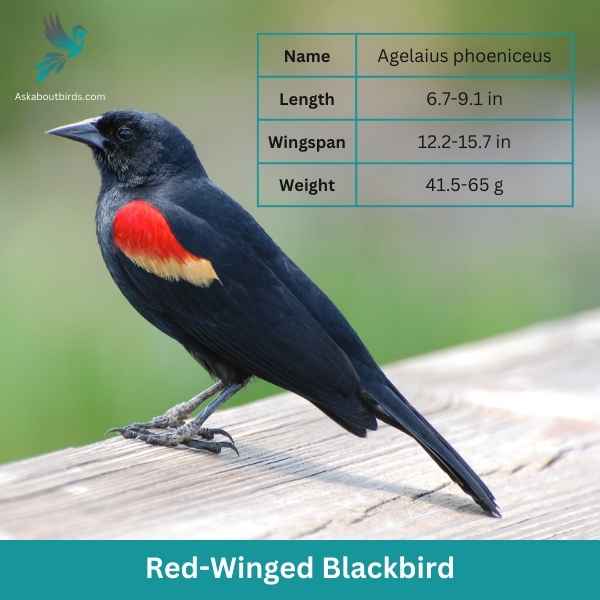
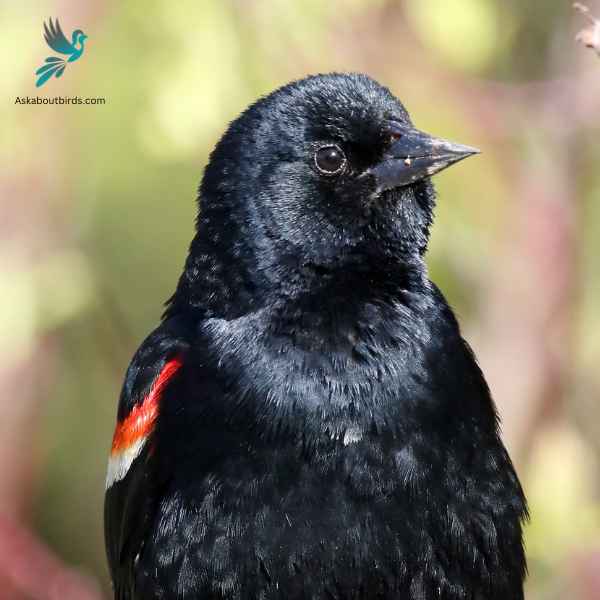
| Feature | Measurement |
|---|---|
| Scientific Name | Agelaius phoeniceus |
| Length | 6.7-9.1 in |
| Wingspan | 12.2-15.7 in |
| Weight | 41.5-65 g |
The Red-Winged Blackbird is a familiar sight across North America, especially in wetlands and open areas. Known for its striking coloration and distinct call, it is often seen perched on cattails or utility lines.
Appearance: Male Red-Winged Blackbirds are glossy black with bright red-and-yellow shoulder patches, while females are streaky brown, resembling a large sparrow. The males’ red patches become more prominent when they’re displaying or agitated.
Diet: Red-Winged Blackbirds primarily feed on seeds and insects. Their diet includes grains, sunflower seeds, and corn, but they also eat beetles, caterpillars, and other small invertebrates, especially in the breeding season.
Reproduction: Red-Winged Blackbirds nest in marshes, along watercourses, and in wet fields. The female constructs a cup-shaped nest using grass and sedge, attaching it to plants above water. She typically lays a clutch of 3 to 4 blue-green eggs, which she incubates for about 11-12 days. Males, being polygynous, often have multiple mates during a single breeding season.
Where to Spot Oregon’s Red Birds
Oregon’s diverse landscapes serve as a vibrant canvas for birdwatchers, especially those with a penchant for red avian species. Here are some of the state’s prime locations that offer spectacular bird-watching opportunities:
- Malheur National Wildlife Refuge: Located in southeastern Oregon, this refuge provides a sanctuary for migratory birds and waterfowl, making it a hotspot for birdwatchers. The wetlands and meadows attract a myriad of species.
- Rogue River Valley: This lush valley, with its mix of forests and open spaces, supports a diverse range of birdlife. The river itself acts as an alluring habitat for various species.
- Mount Hood National Forest: With varying elevations and habitats, from alpine meadows to dense woodlands, this area is home to numerous bird species, including some vibrant red ones.
- Klamath Basin: Straddling the border of Oregon and California, the wetlands here are a significant stopover for migratory birds, offering birdwatchers a chance to spot a wide variety of species.
- Oregon Coast: Stretching for over 360 miles, the coastal habitats are a haven for seabirds, shorebirds, and other avian wonders, making it an irresistible spot for enthusiasts.
| State’s Red Birds | Best Spots to See Red Birds |
|---|---|
| California’s Red birds | 1. Point Reyes National Seashore 2. Salton Sea 3. Big Sur Coastline |
| Nevada’s Red birds | 1. Ruby Lake National Wildlife Refuge 2. Lahontan State Recreation Area 3. Ash Meadows National Wildlife Refuge |
| Washington’s Red birds | 1. Skagit Valley 2. Nisqually National Wildlife Refuge 3. San Juan Islands |
| Idaho’s Red birds | 1. Coeur d’Alene Lake 2. Camas National Wildlife Refuge 3. Snake River Canyon |
FAQs on Red Bird Species Found in Oregon
Why are black oil sunflower seeds a preferred choice for purple finches in backyard feeders?
Black oil sunflower seeds are a top pick for many birds, including the distinct purple finches, especially when placed in backyard feeders within northern and western states. These seeds are packed with essential nutrients, offering the birds the energy they require. Purple finches, with their vibrant tail feathers and two white wing bars, frequent backyard feeders containing these seeds. These seeds, coupled with their dense vegetation or forest edges settings, create a perfect ambiance for bird enthusiasts to observe the rich behavior and interactions of these tiny birds.
What distinguishes the painted bunting from other birds in South and Central America?
Painted buntings, with their dazzling bright blue heads, green wings, and striking yellow feathers, stand out significantly in the avian world, especially in the regions of Central and South America. These tiny birds prefer semi-open habitats and often find refuge in dense vegetation or forest edges. Male painted buntings, in particular, are renowned for their multicolored plumage which contrasts the pale brown shades seen in many other birds. They’re considered a rare species, but their occasional appearance, especially near fruit trees or sunflower seed feeders, leaves an indelible mark on birdwatchers.
Are white-winged crossbills common in the evergreen forests of the Willamette National Forest?
White-winged crossbills, adorned with large white wing patches, are a fascinating sight in evergreen forests. While they are spotted across various regions, the dense coniferous habitats of the Willamette National Forest serve as a prime location for these birds. They thrive on conifer seeds, which are abundant in this region. These medium-sized birds, often seen in large flocks, have a unique behavior of prying open conifer cones, making their presence a delightful spectacle for bird lovers exploring the forest canopy.




